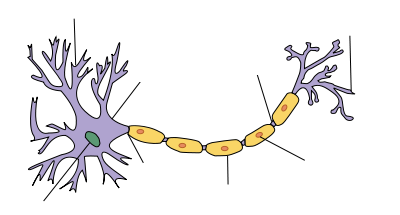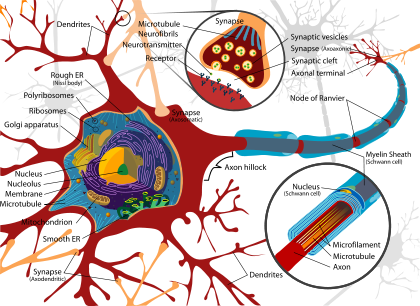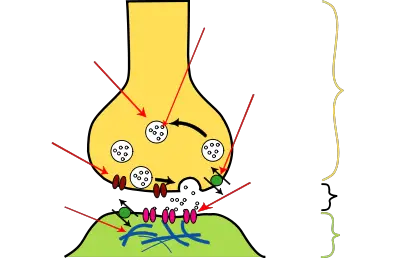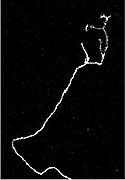Axon
| Axon |
|---|
| Structure of a typical neuron |
An axon is a slender, armlike (or cable-like) projection that extends from the body of a neuron (nerve cell) and conducts nerve impulses along its length. Typically, but not always, axons conduct nerve impulses away from the cell body, causing at their terminal end the release of neurotransmitters into extracellular space, where they can excite or inhibit other neurons. In some sensory neurons, the nerve impulses travel along an axon from the periphery to the cell body.
In many cases, a neuron's axon can be very long, and as such is known as a nerve fiber. Giraffes have single axons several meters in length running along the entire length of the neck and a human motor neuron can be over a meter long, reaching from the lumbar region of the spine to the toes. However, some neurons have axons that are very short and even absent. While a neuron does not have more than one axon, some axons may have branches and such branches can be considerable near the end of an axon's length, including with 10,000 or more terminal branches.
An axon is one of two types of processes that extend from a neuron cell body, the other being dendrites. Dendrites are branched (not arm-like) projections that typically receive signals from other neurons and transmit the signals toward the cell body, normally using short-distance graded potentials rather than the action potentials (nerve impulses) of axons. Axons have most of the same organelles as the dendrites and the cell body, but lack Golgi apparatus and Nissl bodies.
Axons are the primary transmission lines of the nervous system. The coordination between the many complex parts and processes of axon—nodes of Ranvier, all-or-nothing action potentials, calcium ion channels, vesicles filled with neurotransmitter, receptors, and so forth—reflect a remarkable harmony in nature.
Overview
An axon is a projection of a neuron. A neuron or nerve cell is a highly specialized, electrically excitable cell in the nervous system that conducts nerve impulses between different parts of the body. Neurons can process and transmit information from both internal and external environments, communicating this information via chemical or electronic impulse across a synapse (the junction between cells) and utilizing the action potential—an electrical signal that is generated by means of the electrically excitable membrane of the neuron. In vertebrate animals, neurons are the core components of the brain, spinal cord, and peripheral nerves.
The three basic types of neurons are sensory neurons (which have specialized receptors to convert diverse stimuli from the environment into electric signals and then pass this information to a more central location in the nervous system, such as the spinal cord or brain); motor neurons (which transmit impulses from a central area of the nervous system to an effector, such as a muscle); and interneurons or relay neurons (which convert chemical information back to electric signals).
The three main structural regions of a typical neuron are: A soma, or cell body, which contains the nucleus; one or more dendritic trees that typically receive input; and an axon that carries an electric impulse. One can also separate out from the axon a region designated as the axon terminal, which refers to the small branches of the axon that form the synapses, or connections with other cells and often functions to transmit signals to the other cells.
The soma or perikaryon is the bulbous end of a neuron, from which the dendrites and axon branch off. The soma contains many organelles, granules called Nissl granules, and its key feature is the presence of the cell nucleus.
Dendrites are one of the two types of protoplasmic protrusions that extrude from the cell body of a neuron. These are cellular extensions with many branches and is the region where the majority of input to the neuron occurs. The overall shape and structure of a neuron's dendrites is called its dendritic tree. Most neurons have multiple dendrites, which extend outward from the soma and are specialized to receive chemical signals from the axon termini of other neurons. Dendrites convert these signals into small electric impulses and transmit them to the soma.
Axons are the second of the two types of protoplasmic protrusions extending from the cell bodies of neurons. The axon is a slender, cable-like projection that can extend tens, hundreds, or even tens of thousands of times the diameter of the soma in length and typically conducts electrical impulses away from the neuron's cell body. The function of the axon is to transmit information to different neurons, muscles, and glands. In certain sensory neurons (pseudounipolar neurons), such as those for touch and warmth, the electrical impulse travels along an axon from the periphery to the cell body, and from the cell body to the spinal cord along another branch of the same axon.
Axons are distinguished from dendrites by several features, including shape (dendrites often taper while axons usually maintain a constant radius), length (dendrites are restricted to a small region around the cell body while axons can be much longer), and function (dendrites usually receive signals while axons usually transmit them). All of these rules have exceptions, however. For example, while the axon and axon hillock are generally involved in information outflow, this region can also receive input from other neurons. Information outflow from dendrites to other neurons can also occur. And axons can be very short (and even absent) in some types of neurons. Those types of neurons that lack an axon transmit signals from their dendrites. Both dendrites and axons tend to share the same organelles as the soma, although both lack the nucleus, and axons lack Golgi apparatus and Nissl bodies.
The distinction between dendrites and axons is not always clear. For example, neurons classified as unipolar (or pseudounipolar, since they originate as bipolar neurons) have one process that extends from the cell body and it forms two ends (a central process and a peripheral process, both with branches at their ends, where there are sensory endings/receptive terminals). These are chiefly sensory neurons of the peripheral nervous system. Some classify this extension as a dendrite, using the older definition of dendrites as processes that transmit impulses toward the cell body. However, functional definitions based on the generation and transmission of an impulse classify this as an axon (Marieb and Hoehn 2010).
No neuron ever has more than one axon; however in invertebrates such as insects or leeches the axon sometimes consists of several regions that function more or less independently of each other (Yau 1976).
The axon is specialized for the conduction of the electric impulse called the action potential, which travels away from the cell body and down the axon. The junction of the axon and the cell body is called the axon hillock ("little hill"). This is the area of the neuron that has the greatest density of voltage-dependent sodium channels, making it the most easily excited part of the neuron. Axons make contact with other cells—usually other neurons but sometimes muscle or gland cells—at junctions called synapses. At a synapse, the membrane of the axon closely adjoins the membrane of the target cell, and special molecular structures serve to transmit electrical or electrochemical signals across the gap. Most axons branch, in some cases extensively, enabling communication with many target cells. Some synaptic junctions appear partway along an axon as it extends—these are called en passant ("in passing") synapses. Other synapses appear as terminals at the ends of axonal branches. A single axon, with all its branches taken together, can innervate multiple parts of the brain and generate thousands of synaptic terminals.
Anatomy
Axons are the primary transmission lines of the nervous system, and as bundles they form nerves. Some axons can extend up to one meter or more while others extend as little as one millimeter. The longest axons in the human body are those of the sciatic nerve, which run from the base of the spinal cord to the big toe of each foot. The diameter of axons is also variable. Most individual axons are microscopic in diameter (typically about 1 micron across). The largest mammalian axons can reach a diameter of up to 20 microns. The squid giant axon, which is specialized to conduct signals very rapidly, is close to 1 millimeter in diameter, the size of a small pencil lead. Axonal arborization (the branching structure at the end of a nerve fiber) also differs from one nerve fiber to the next. Axons in the central nervous system typically show complex trees with many branch points. In comparison, the cerebellar granule cell axon is characterized by a single T-shaped branch node from which two parallel fibers extend. Elaborate arborization allows for the simultaneous transmission of messages to a large number of target neurons within a single region of the brain.
There are two types of axons occurring in the peripheral system and the central nervous system: unmyelinated and myelinated axons. Myelin is a layer of a fatty insulating substance, and myelin sheaths around axons protect and electrically insulates the axon (Marieb and Hoehn 2010). Myelin is formed by two types of glial cells: Schwann cells ensheathing peripheral neurons and oligodendrocytes insulating those of the central nervous system. Along myelinated nerve fibers, gaps in the myelin sheath known as nodes of Ranvier occur at evenly spaced intervals. The myelination of axons (myelinated fibers—those with a myselin sheath) enables an especially rapid mode of electrical impulse propagation called saltatory conduction. Unmyelinated fibers transmit nerve impulses quite slowly (Marieb and Hoehn 2010). Demyelination of axons causes the multitude of neurological symptoms found in the disease Multiple sclerosis.
If the brain or spinal cord of a vertebrate is extracted and sliced into thin sections, some parts of each section appear dark and other parts lighter in color. The dark parts are known as gray matter and the lighter parts as white matter. White matter gets its light color from the myelin sheaths of axons: the white matter parts of the brain are characterized by a high density of myelinated axons passing through them, and a low density of cell bodies of neurons. Spinal and cerebral white matter do not contain dendrites, which can only be found in gray matter. Gray matter contains dendrites, along with neural cell bodies and shorter, unmylinated axons. The cerebral cortex has a thick layer of gray matter on the surface; underneath this is a large volume of white matter: what this means is that most of the surface is filled with neuron cell bodies, whereas much of the area underneath is filled with myelinated axons that connect these neurons to each other. Generally, white matter can be understood as the parts of the brain and spinal cord responsible for information transmission (axons); whereas, gray matter is mainly responsible for information processing (neuron bodies). In the human spinal cord, the axons coated with myelin are on the surface and the axon-dendrite networks are on the inside, while in the brain this is reversed (i.e, in the spinal cord, white matter is on the outside, while it is predominately on the inside in the brain (Chamberlin and Narins 2005; Campbell et al. 2008; Marieb and Hoehn 2010).
Initial segment
The axon initial segment—the thick, unmyelinated part of an axon that connects directly to the cell body—consists of a specialized complex of proteins. It is approximately 25μm in length and functions as the site of action potential initiation (Clark et al. 2009). The density of voltage-gated sodium channels is much higher in the initial segment than in the remainder of the axon or in the adjacent cell body, excepting the axon hillock (Wollner and Catterall 1986).
The voltage-gated ion channels are known to be found within certain areas of the axonal membrane and initiate action potential, conduction, and synaptic transmission (Debanne et al. 2011).
Nodes of Ranvier
Nodes of Ranvier (also known as myelin sheath gaps) are short unmyelinated segments of a myelinated axon, which are found periodically interspersed between segments of the myelin sheath. Therefore, at the point of the node of Ranvier, the axon is reduced in diameter (Hess and Young 1952). These nodes are areas where action potentials can be generated. In saltatory conduction, electrical currents produced at each node of Ranvier are conducted with little attenuation to the next node in line, where they remain strong enough to generate another action potential. Thus in a myelinated axon, action potentials effectively "jump" from node to node, bypassing the myelinated stretches in between, resulting in a propagation speed much faster than even the fastest unmyelinated axon can sustain.
Action potentials
| Structure of a typical chemical synapse |
|---|
Most axons carry signals in the form of action potentials, which are discrete electrochemical impulses that travel rapidly along an axon, starting at the cell body and terminating at points where the axon makes synaptic contact with target cells. The defining characteristic of an action potentials is that it is "all-or-nothing"—every action potential that an axon generates has essentially the same size and shape. This all-or-nothing characteristic allows action potentials to be transmitted from one end of a long axon to the other without any reduction in size. There are, however, some types of neurons with short axons that carry graded electrochemical signals, of variable amplitude.
When an action potential reaches a presynaptic terminal, it activates the synaptic transmission process. The first step is rapid opening of calcium ion channels in the membrane of the axon, allowing calcium ions to flow inward across the membrane. The resulting increase in intracellular calcium concentration causes vesicles (tiny containers enclosed by a lipid membrane) filled with a neurotransmitter chemical to fuse with the axon's membrane and empty their contents into the extracellular space. The neurotransmitter is released from the presynaptic nerve through exocytosis. The neurotransmitter chemical then diffuses across to receptors located on the membrane of the target cell. The neurotransmitter binds to these receptors and activates them. Depending on the type of receptors that are activated, the effect on the target cell can be to excite the target cell, inhibit it, or alter its metabolism in some way. This entire sequence of events often takes place in less than a thousandth of a second. Afterward, inside the presynaptic terminal, a new set of vesicles are moved into position next to the membrane, ready to be released when the next action potential arrives. The action potential is the final electrical step in the integration of synaptic messages at the scale of the neuron (Debanne et al. 2011).
Growth and development
Growing axons move through their environment via the growth cone, which is at the tip of the axon. The growth cone has a broad sheet like extension called lamellipodia, which contain protrusions called filopodia. The filopodia are the mechanism by which the entire process adheres to surfaces and explores the surrounding environment. Actin plays a major role in the mobility of this system.
Environments with high levels of cell adhesion molecules or CAM's create an ideal environment for axonal growth. This seems to provide a "sticky" surface for axons to grow along. Examples of CAM's specific to neural systems include N-CAM, neuroglial CAM or NgCAM, TAG-1, and MAG all of which are part of the immunoglobulin superfamily. Another set of molecules called extracellular matrix adhesion molecules also provide a sticky substrate for axons to grow along. Examples of these molecules include laminin, fibronectin, tenascin, and perlecan. Some of these are surface bound to cells and thus act as short range attractants or repellents. Others are diffusible ligands and thus can have long range effects.
Cells called guidepost cells assist in the guidance of neuronal axon growth. These cells are typically other, sometimes immature, neurons.
It has also been discovered through research that if the axons of a neuron were damaged, as long as the soma (the cell body of a neuron) is not damaged, the axons would regenerate and remake the synaptic connections with neurons with the help of guidepost cells. This is also referred to as neuroregeneration (Kunik et al. 2011).
Nogo-A is a type of neurite growth inhibitory component that is present in the central nervous system myelin membranes (found in an axon). It has a crucial role in restricting axonal regeneration in the adult mammalian central nervous system. In recent studies, if Nogo- A is blocked and neutralized, it is possible to induce long-distance axonal regeneration, which leads to enhancement of functional recovery in rats and mouse spinal cord. This has yet to be done on humans (Schwab 2004). A recent study has also found that macrophages activated through a specific inflammatory pathway activated by the Dectin-1 receptor are capable of promoting axon recovery, also however causing neurotoxicity in the neuron (Gensel et al. 2009).
History
Some of the first intracellular recordings in a nervous system were made in the late 1930s by K. Cole and H. Curtis. German anatomist Otto Friedrich Karl Deiters is generally credited with the discovery of the axon by distinguishing it from the dendrites (Debanne et al. 2011). Swiss Rüdolf Albert von Kölliker and German Robert Remak were the first to identify and characterize the axon initial segment. Alan Hodgkin and Andrew Huxley also employed the squid giant axon (1939) and by 1952 they had obtained a full quantitative description of the ionic basis of the action potential, leading the formulation of the Hodgkin-Huxley Model.
Hodgkin and Huxley were awarded jointly the Nobel Prize for this work in 1963. The formulas detailing axonal conductance were extended to vertebrates in the Frankenhaeuser-Huxley equations. Louis-Antoine Ranvier was the first to describe the gaps or nodes found on axons and for this contribution these axonal features are now commonly referred to as the Nodes of Ranvier. Santiago Ramón y Cajal, a Spanish anatomist, proposed that axons were the output components of neurons, describing their functionality (Debanne et al. 2011). Erlanger and Gasser earlier developed the classification system for peripheral nerve fibers, based on axonal conduction velocity, myelination, fiber size, and so forth. Even recently our understanding of the biochemical basis for action potential propagation has advanced, and now includes many details about individual ion channels.
Injury
In order of degree of severity, injury to a nerve can be described as neuropraxia, axonotmesis, or neurotmesis. Concussion is considered a mild form of diffuse axonal injury (Dawodu 2013). The dysfunction of axons in the nervous system is one of the major causes of many inherited neurological disorders that affect both peripheral and central neurons (Debanne et al. 2011).
Classification
The axons that make up nerves in the human peripheral nervous system can be classified based on their physical features and signal conduction properties.
Motor
Lower motor neurons have two kind of fibers:
| Type | Erlanger-Gasser Classification |
Diameter | Myelin | Conduction velocity | Associated muscle fibers |
|---|---|---|---|---|---|
| α | Aα | 13-20 µm | Yes | 80–120 m/s | Extrafusal muscle fibers |
| γ | Aγ | 5-8 µm | Yes | 4–24 m/s[1][2] | Intrafusal muscle fibers |
Sensory
Different sensory receptors are innervated by different types of nerve fibers. Proprioceptors are innervated by type Ia, Ib and II sensory fibers, mechanoreceptors by type II and III sensory fibers and nociceptors and thermoreceptors by type III and IV sensory fibers.
| Type | Erlanger-Gasser Classification |
Diameter | Myelin | Conduction velocity | Associated sensory receptors |
|---|---|---|---|---|---|
| Ia | Aα | 13-20 µm | Yes | 80–120 m/s | Primary receptors of muscle spindle |
| Ib | Aα | 13-20 µm | Yes | 80–120 m/s | Golgi tendon organ |
| II | Aβ | 6-12 µm | Yes | 33–75 m/s | Secondary receptors of muscle spindle All cutaneous mechanoreceptors |
| III | Aδ | 1-5 µm | Thin | 3–30 m/s | Free nerve endings of touch and pressure Nociceptors of neospinothalamic tract Cold thermoreceptors |
| IV | C | 0.2-1.5 µm | No | 0.5-2.0 m/s | Nociceptors of paleospinothalamic tract Warmth receptors |
Autonomic
The autonomic nervous system has two kinds of peripheral fibers:
| Type | Erlanger-Gasser Classification |
Diameter | Myelin[3] | Conduction velocity |
|---|---|---|---|---|
| preganglionic fibers | B | 1-5 µm | Yes | 3–15 m/s |
| postganglionic fibers | C | 0.2-1.5 µm | No | 0.5-2.0 m/s |
Notes
- ↑ B. L. Andrew, and N. J. Part, "Properties of fast and slow motor units in hind limb and tail muscles of the rat," Q J Exp Physiol Cogn Med Sci 57 (1972): 213-225.
- ↑ N. J. Russell, "Axonal conduction velocity changes following muscle tenotomy or deafferentation during development in the rat," J Physiol 298(1980): 347–360. PMID 7359413.
- ↑ G. Pocock, C. D. Richards, and M. de Burgh Daly. 2004. Human Physiology. Oxford: Oxford University Press, pp.187-9. ISBN 0198585276
ReferencesISBN links support NWE through referral fees
- Campbell, N. A., J. B. Reece, L. A. Urry, et al. 2008. Biology, 8th edition. San Francisco: Pearson/Benjamin Cummings. ISBN 9780805368444.
- Chamberlin, S. L., and B. Narins. 2005. The Gale Encyclopedia of Neurological Disorders. Detroit: Thomson Gale. ISBN 078769150X.
- Clark, B. D., E. M. Goldberg, and B. Rudy. 2009. Electrogenic Tuning of the Axon Initial Segment. Neuroscientist 15: 651–668. PMID 20007821. Retrieved July 8, 2013.
- Dawodu, S. T. 2013. Traumatic brain injury (TBI): Definition, epidemiology, pathophysiology. Medscape. Retrieved July 8, 2013.
- Debanne, D., E. Campanac, A. Bialowas, E. Carlier, and G. Alcaraz. 2011. Axon physiology. Physiological Reviews 91(2): 555–602. PMID 21527732.
- Gensel, J. C., S. Nakamura, Z. Guan, N. van Rooijen, D. P. Ankeny, and P. G. Popovich. 2009. Macrophages promote axon regeneration with concurrent neurotoxicity. Journal of Neuroscience 29(12): 3956–3968. Retrieved July 8, 2013.
- Hess, A., and J. Z. Young. 1952. The nodes of Ranvier. Proceedings of the Royal Society of London 140(900): 301–320. PMID 13003931.
- Kunik, D., C. Dion, T. Ozaki, L. A. Levin, and S. Costantino. 2011. Laser-based single-axon transection for high-content axon injury and regeneration studies. PLoS One 6(11):e26832. Retrieved July 8, 2012.
- Marieb, E. N. and K. Hoehn. 2010. Human Anatomy & Physiology, 8th edition. Benjamin Cummings. ISBN 9780805395693.
- Schwab, M. E. 2004. Nogo and axon regeneration. Current Opinion in Neurobiology 14(1): 118-124. Retrieved July 8, 2012.
- Yau, K. -W. 1976. Receptive fields, geometry and conduction block of sensory neurons in the CNS of the leech. J. Physiol. 263:513-538. </ref>
- Wollner, D., and W. A. Catterall. 1986. Localization of sodium channels in axon hillocks and initial segments of retinal ganglion cells. Proc. Nati. Acad. Sci. USA 83: 8424–28. PMID 2430289.
Credits
New World Encyclopedia writers and editors rewrote and completed the Wikipedia article in accordance with New World Encyclopedia standards. This article abides by terms of the Creative Commons CC-by-sa 3.0 License (CC-by-sa), which may be used and disseminated with proper attribution. Credit is due under the terms of this license that can reference both the New World Encyclopedia contributors and the selfless volunteer contributors of the Wikimedia Foundation. To cite this article click here for a list of acceptable citing formats.The history of earlier contributions by wikipedians is accessible to researchers here:
The history of this article since it was imported to New World Encyclopedia:
Note: Some restrictions may apply to use of individual images which are separately licensed.





